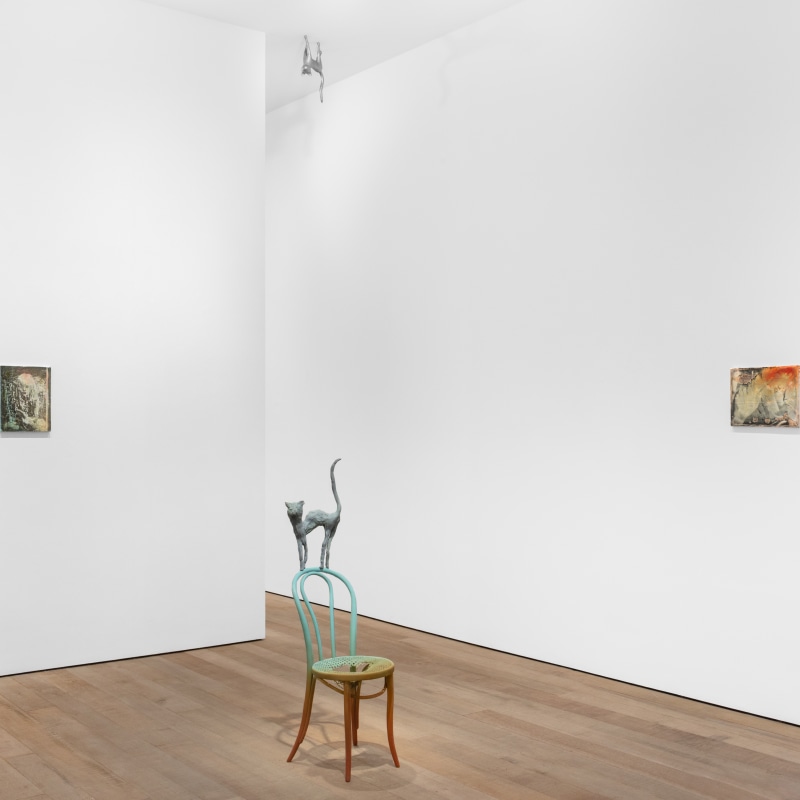In direct comparison to the advanced technology and monumental ambition of his recent large installations such as PLAY, for this exhibition in London Urs Fischer has initiated experiments in a very different register. The new body of work at Bury Street is modest in scale and predominantly analogue in production. In a low-fi darkroom in his studio, small paintings are coated with exposure emulsion to receive layer upon layer of photographic images, resulting in a surprising unpredictability for both the artist and viewer. The source images are snapshots of the box-under-the-bed kind, memories of family ancestry and personal biography, which morph into unexpected hybrids recalling the ghostly spiritual apparitions of Victorian photography. Faces are pulled out of the ether to propose cloudy memories of looped familial relationships, the like of which every person has, with the analogue qualities emphasising our sense of the imperfect match of historical document with actual memory. Like Andy Warhol’s 13 Most Wanted Men, which also employs a convention of portraiture (the criminal mugshot), family portrait photography remains as timeless and interchangeable as the patterns of family behaviour. Ultimately, despite the personal nature of such pictures, everyone is reduced to an anonymous cliche. Alongside these memory paintings, Fischer will exhibit new small scale cast sculptures that challenge physical logic either in construction, materiality or display. Repeatedly using a cat as subject, the artist’s spirit animus, the sculptures embody a playful and hypnotic charm.
In all his work, be it sculpture, installation or painting, Fischer habitually disrupts form and image to engage and surprise. He teases our conventions of looking and resists our understanding of the ‘truth or fiction' of a picture or a sculpture through a puzzling distortion of physical qualities, degradation of materials through time or process, the warping of perspective and the inversion of retinal logic. Often the viewer is simultaneously looking at both painting and photograph, trying to deduct which has dominance or more authority. Fischer is a sorcerer who with these new works imagines old histories in new forms, treating memory as a residue that is always in the present morphing and adapting to fit the changing nature of current truths. This presentation embraces the slowness of extracting an image during the painstaking process of old school photography and is the reverse of the speed and efficiency of the tsunami of images our digital era offers. Ultimately though, the data holding our precious pictorial memories is tenuous, unreliable, exploitable and less tangible than those contained in a box passed from generation to generation.
Urs Fischer (b. Switzerland, 1973) lives in New York. Recent major exhibitions include PLAY, Tel Aviv Museum of Art, Tel Aviv (2022); Lovers, Museo Jumex, Mexico City (2022); The Intelligence of Nature, Sadie Coles HQ, London (2021); Bourse de Commence: Pinault Collection, Paris (2021); Aïshti Foundation, Beirut (2020); ERROR, The Brant Foundation, Greenwich (2019); soft, Sadie Coles HQ, London (2018); Big Clay #4 and Two Tuscan Men, Piazza della Signoria, Florence (2017); The Public & the Private, Legion of Honor, San Francisco (2017); The Kiss, Sadie Coles HQ, London (2017); Small Axe, Garage Museum of Contemporary Art, Moscow (2016); MOCA, Los Angeles (2013); Madame Fisscher, Palazzo Grassi, Venice (2012); and Skinny Sunrise, Kunsthalle Wien, Vienna (2012). He has had solo shows throughout Europe and the USA, including Oscar the Grouch, The Brant Foundation, Greenwich (2010) and Marguerite de Ponty, New Museum, New York (2009). In 2004, Not My House Not My Fire took place at Espace 315, Centre Pompidou, Paris, and the retrospective Kir Royal was held at Kunsthaus Zürich, Switzerland. Urs Fischer’s work has been included in numerous group exhibitions including the Venice Biennale in 2003, 2007, and 2011. In 2022, a major new permanent public commission, entitled L’arc, was unveiled at Station F in Paris.
